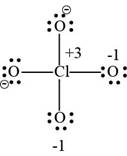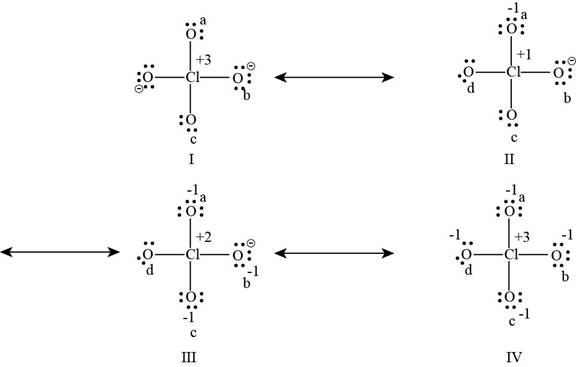
Concept explainers
Interpretation: The Lewis structure and shape of the given compound, the hybridization of the central atom and the resonating structure that has formal charge close to zero is to be identified.
Concept introduction: The Lewis structure represents all bonding and non-bonding electrons surrounding the atoms involved in a molecule. A molecule exhibits a particular geometry in space considering the steric hindrances of the bond pairs and the lone pairs of electron.
Resonance structures are different forms of a molecule in which the chemical connectivity of the atoms in a molecule is same but there distribution of electrons is different.
The formal charge is calculated by the formula,
To determine: The Lewis structure and shape of the given compound, the hybridization of the central atom and the resonating structure that has formal charge close to zero.
Answer to Problem 9.65QP
Solution
The Lewis structure of
The resonating structure I has formal charge close to zero.
The shape of the molecule is tetrahedral and the hybridization of the chlorine is
Explanation of Solution
Explanation
The
The electronic configuration of
The number of valence electrons of
The atomic number of
The electronic configuration of
The number of valence electrons of
The total number of valence electrons of
The Lewis structure of

Figure 1
Resonance structures are different forms of a molecule in which the chemical connectivity of the atoms in a molecule is same but there distribution of electrons is different.
The resonance structure of

Figure 2
The formal charge is calculated by the formula,
According to the I resonating structure of the given compound from figure 2,
- Chlorine has fourteen bonding and zero nonbonding electrons.
- Oxygen (a) has four bonding electrons and four nonbonding electrons.
- Oxygen (b) has two bonding and six nonbonding electrons.
- Oxygen (c) has four bonding electrons and four nonbonding electrons.
- Oxygen (d) has four bonding and four nonbonding electrons.
The formal charge of chlorine in resonating structure 1 is calculated as,
The formal charge of oxygen (a) in resonating structure 1 is calculated as,
The formal charge of oxygen (b) in resonating structure 1 is calculated as,
The formal charge of oxygen (c) in resonating structure 1 is calculated as,
The formal charge of oxygen (d) in resonating structure 1 is calculated as,
According to the II resonating structure of the given compound from figure 2,
- Chlorine has twelve bonding and zero nonbonding electrons.
- Oxygen (a) has two bonding electrons and six nonbonding electrons.
- Oxygen (b) has two bonding and six nonbonding electrons.
- Oxygen (c) has four bonding electrons and four nonbonding electrons.
- Oxygen (d) has four bonding and four nonbonding electrons.
The formal charge of chlorine in resonating structure 1 is calculated as,
The formal charge of oxygen (a) in resonating structure 1 is calculated as,
The formal charge of oxygen (b) in resonating structure 1 is calculated as,
The formal charge of oxygen (c) in resonating structure 1 is calculated as,
The formal charge of oxygen (d) in resonating structure 1 is calculated as,
According to the II resonating structure of the given compound from figure 2,
- Chlorine has fourteen bonding and zero nonbonding electrons.
- Oxygen (a) has four bonding electrons and six nonbonding electrons.
- Oxygen (b) has two bonding and six nonbonding electrons.
- Oxygen (c) has four bonding electrons and six nonbonding electrons.
- Oxygen (d) has four bonding and four nonbonding electrons.
The formal charge of chlorine in resonating structure 1 is calculated as,
The formal charge of oxygen (a) in resonating structure 1 is calculated as,
The formal charge of oxygen (b) in resonating structure 1 is calculated as,
The formal charge of oxygen (c) in resonating structure 1 is calculated as,
The formal charge of oxygen (d) in resonating structure 1 is calculated as,
According to the IV resonating structure of the given compound from figure 2,
- Chlorine has ten bonding and zero nonbonding electrons.
- Oxygen (a) has two bonding electrons and six nonbonding electrons.
- Oxygen (b) has two bonding and six nonbonding electrons.
- Oxygen (c) has two bonding electrons and six nonbonding electrons.
- Oxygen (d) has four bonding and four nonbonding electrons.
The formal charge of chlorine in resonating structure 1 is calculated as,
The formal charge of oxygen (a) in resonating structure 1 is calculated as,
The formal charge of oxygen (b) in resonating structure 1 is calculated as,
The formal charge of oxygen (c) in resonating structure 1 is calculated as,
The formal charge of oxygen (d) in resonating structure 1 is calculated as,
Resonating structure 1 has formal charge close to zero
The molecular shape of
From the resonating structure I it is concluded that the chlorine atom forms three pi bonds this means it uses three
Conclusion
The Lewis structure of
The resonating structure I has formal charge close to zero.
The shape of the molecule is tetrahedral and the hybridization of the chlorine is
Want to see more full solutions like this?
Chapter 9 Solutions
Chemistry Smartwork Access Code Fourth Edition
- 1. Show the steps necessary to make 2-methyl-4-nonene using a Wittig reaction. Start with triphenylphosphine and an alkyl halide. After that you may use any other organic or inorganic reagents. 2. Write in the product of this reaction: CH3 CH₂ (C6H5)₂CuLi H₂O+arrow_forward3. Name this compound properly, including stereochemistry. H₂C H3C CH3 OH 4. Show the step(s) necessary to transform the compound on the left into the acid on the right. Bri CH2 5. Write in the product of this LiAlH4 Br H₂C OHarrow_forwardWhat are the major products of the following reaction? Please provide a detailed explanation and a drawing to show how the reaction proceeds.arrow_forward
- What are the major products of the following enolate alkylation reaction? Please include a detailed explanation as well as a drawing as to how the reaction proceeds.arrow_forwardA block of zinc has an initial temperature of 94.2 degrees celcius and is immererd in 105 g of water at 21.90 degrees celcius. At thermal equilibrium, the final temperature is 25.20 degrees celcius. What is the mass of the zinc block? Cs(Zn) = 0.390 J/gxdegrees celcius Cs(H2O) = 4.18 J/gx degrees celcusarrow_forwardPotential Energy (kJ) 1. Consider these three reactions as the elementary steps in the mechanism for a chemical reaction. AH = -950 kJ AH = 575 kJ (i) Cl₂ (g) + Pt (s) 2C1 (g) + Pt (s) Ea = 1550 kJ (ii) Cl (g)+ CO (g) + Pt (s) → CICO (g) + Pt (s) (iii) Cl (g) + CICO (g) → Cl₂CO (g) Ea = 2240 kJ Ea = 2350 kJ AH = -825 kJ 2600 2400 2200 2000 1800 1600 1400 1200 1000 a. Draw the potential energy diagram for the reaction. Label the data points for clarity. The potential energy of the reactants is 600 kJ 800 600 400 200 0 -200- -400 -600- -800- Reaction Progressarrow_forward
- Can u help me figure out the reaction mechanisms for these, idk where to even startarrow_forwardHi, I need your help with the drawing, please. I have attached the question along with my lab instructions. Please use the reaction from the lab only, as we are not allowed to use outside sources. Thank you!arrow_forwardHi, I need your help i dont know which one to draw please. I’ve attached the question along with my lab instructions. Please use the reaction from the lab only, as we are not allowed to use outside sources. Thank you!arrow_forward
- 5. Write the formation reaction of the following complex compounds from the following reactants: 6. AgNO₃ + K₂CrO₂ + NH₄OH → 7. HgNO₃ + excess KI → 8. Al(NO₃)₃ + excess NaOH →arrow_forwardIndicate whether the product formed in the reaction exhibits tautomerism. If so, draw the structure of the tautomers. CO₂C2H5 + CH3-NH-NH,arrow_forwardDraw the major product of this reaction N-(cyclohex-1-en-1-yl)-1-(pyrrolidino) reacts with CH2=CHCHO, heat, H3O+arrow_forward
 ChemistryChemistryISBN:9781305957404Author:Steven S. Zumdahl, Susan A. Zumdahl, Donald J. DeCostePublisher:Cengage Learning
ChemistryChemistryISBN:9781305957404Author:Steven S. Zumdahl, Susan A. Zumdahl, Donald J. DeCostePublisher:Cengage Learning ChemistryChemistryISBN:9781259911156Author:Raymond Chang Dr., Jason Overby ProfessorPublisher:McGraw-Hill Education
ChemistryChemistryISBN:9781259911156Author:Raymond Chang Dr., Jason Overby ProfessorPublisher:McGraw-Hill Education Principles of Instrumental AnalysisChemistryISBN:9781305577213Author:Douglas A. Skoog, F. James Holler, Stanley R. CrouchPublisher:Cengage Learning
Principles of Instrumental AnalysisChemistryISBN:9781305577213Author:Douglas A. Skoog, F. James Holler, Stanley R. CrouchPublisher:Cengage Learning Organic ChemistryChemistryISBN:9780078021558Author:Janice Gorzynski Smith Dr.Publisher:McGraw-Hill Education
Organic ChemistryChemistryISBN:9780078021558Author:Janice Gorzynski Smith Dr.Publisher:McGraw-Hill Education Chemistry: Principles and ReactionsChemistryISBN:9781305079373Author:William L. Masterton, Cecile N. HurleyPublisher:Cengage Learning
Chemistry: Principles and ReactionsChemistryISBN:9781305079373Author:William L. Masterton, Cecile N. HurleyPublisher:Cengage Learning Elementary Principles of Chemical Processes, Bind...ChemistryISBN:9781118431221Author:Richard M. Felder, Ronald W. Rousseau, Lisa G. BullardPublisher:WILEY
Elementary Principles of Chemical Processes, Bind...ChemistryISBN:9781118431221Author:Richard M. Felder, Ronald W. Rousseau, Lisa G. BullardPublisher:WILEY





